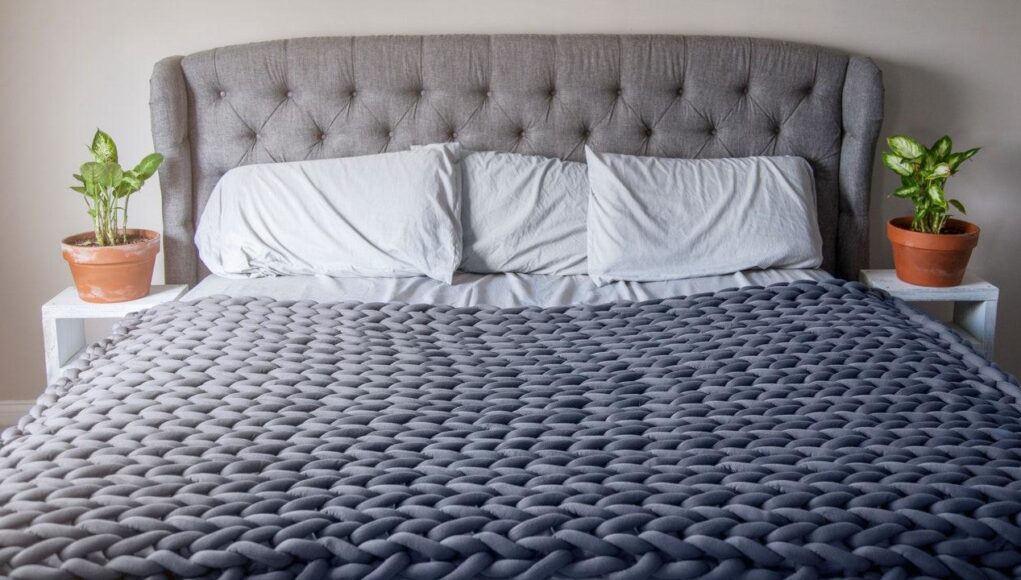As with all of your other bedding, you’ll need to learn how to wash a weighted blanket for hygienic reasons. However, the same factors that make you love your weighted blanket are also the reasons that may cause you to hesitate when it’s time to launder it.
A weighted blanket provides a gentle amount of pressure that can calm your nervous system and make you feel relaxed and happy. In this state of calmness, you can fall asleep quicker and experience a good night’s sleep. These heavy blankets, which can weigh between five to 30 pounds, relieve anxiety and treat insomnia, but because they’re so much heavier than your other bedding, it can be difficult deciding how and when to wash them.
Can you hand wash them to spot clean? Should you throw them into the washing machine on a gentle cycle or not? What’s better: cold water, warm water, or hot water? Should you use a mild detergent like dish soap, or is it safe to use chlorine bleach? What about drying: should you select a low heat setting, fluff, or high heat? Suppose you have a removable cover—does that get thrown in too?
Or should you cart your weighted blanket off to the laundromat and use a commercial washer instead? These are all things you need to carefully consider before you decide how to wash your weighted blanket.
Also, there are different types of weighted blankets. For example, of my favorite weighted blankets, some contain glass microbeads, like the Baloo Weighted Blanket and the Casper Weighted Blanket, while the California Design Den Handmade Weighted Blanket is made of chunky knit. In short, there are tons of options when it comes to this product, and therefore the washing instructions may differ.
I reached out to experts from these companies—Elizabeth Grojean, founder and CEO of Baloo; Deepak Mehrotra, founder of California Design Den; and Melissa Danielson of the product development team at Casper—to discover how to wash a weighted blanket so it continues to look great and perform well for years to come. Here’s what they advised.
Consider size and material
Always consult the manufacturer’s care instructions for specific washing instructions. However, as a general rule, if you want to launder your weighted blanket in the washing machine, it will depend on the blanket’s size. “If your blanket is less than 25 pounds, you can use your washing machine at home,” says Grojean. If your blanket is over 25 pounds, she recommends taking the weighted blanket to a professional laundromat or dry cleaner.
Now, you may be thinking, “Well, if it fits into my washer and dryer, let’s just roll the dice instead of lugging it to a laundromat.” However, Mehrotra says this is a bad idea. If the blanket is too heavy, it could damage your appliances. “Make sure you check your washing machine/dryer load capacity to avoid any damage to them,” Mehrotra advises.
Regarding materials, if it contains glass, plastic, or steel beads—or is a chunky knit weighted blanket—it is machine washable. However, if the fillers in the blanket are rice, beans, or grains, then dry cleaning is the best option.
Spot clean often
Spot cleaning can help to remove spills and stains—and it’s often the method recommended by our experts. “We suggest spot cleaning your blanket when possible to save water and energy, and I highly recommend cold water or warm water—but not hot water—and a gentle soap,” Grojean says.
Also, Danielson recommends scrubbing the stain with an old rag or toothbrush, using gentle detergent or stain removers and warm water.
Mehrotra agrees, adding you could also use any type of brush with soft bristles, but warns against using fabric softeners and bleach, which could damage the product.
Machine wash if you can
Sometimes, spot cleaning is not enough and you really need to clean the entire blanket. When you need to wash the weighted blanket in the machine, Grojean recommends washing the blanket alone, or with a very small load. (To be on the safe side, both Danielson and Mehrotra both advise washing it alone—especially if it’s a chunky knit weighted blanket.)
Be sure to use a gentle cycle since this wash cycle can to help to extend the weighted blanket’s lifespan and preserve its durability.
You should also use a gentle laundry detergent. “Choose one that does not contain harmful chemicals, like bleach, chlorine, and fabric softener, that can damage your blanket’s fabric, which can result in pilling or cause the blanket to lose its softness,” Danielson says.
Be careful with weighted blankets with covers
Some people use a duvet cover on their weighted blanket. If you fall in this category, Grojean recommends removing it so the weighted blanket can be washed separately. Otherwise, you’ll run the risk of overfilling the machine.
Dry the weighted blanket
How you dry your weighted blanket is just as important as how you wash it. “Most weighted blankets can be dried in the dryer on a low heat setting,” Grojean says. “Keep an eye on them because they may dry much faster than you’d expect as the weighted filling made of glass beads does not retain moisture.”
While Danielson agrees that you should use the low heat setting on the dryer, she also believes that air-drying is the safest bet—especially if the blanket has metal beads or chains. Be sure to wring out the excess water first.
But if you have a chunky knit weighted blanket, Mehrotra does not suggest hanging it to air dry, since this process may stretch out the loops. So, you should only tumble dry the piece on low.
How frequently do you need to wash your weighted blanket?
So, how often should you launder your weighted blanket? “This is typically a matter of personal preference, and Danielson says the decision should be based on how heavily the blanket is used and if it has become soiled in any way. “Our recommendation is always to maintain hygiene with sleep or comfort products to keep your home fresh,” she says.
But if you need more specific guidance, Mehrotra offers the following advice. “If you use your weighted blanket daily, then we recommend washing it once per month.” However, if you only use it occasionally, Mehrotra says four to six times a year should be fine.








